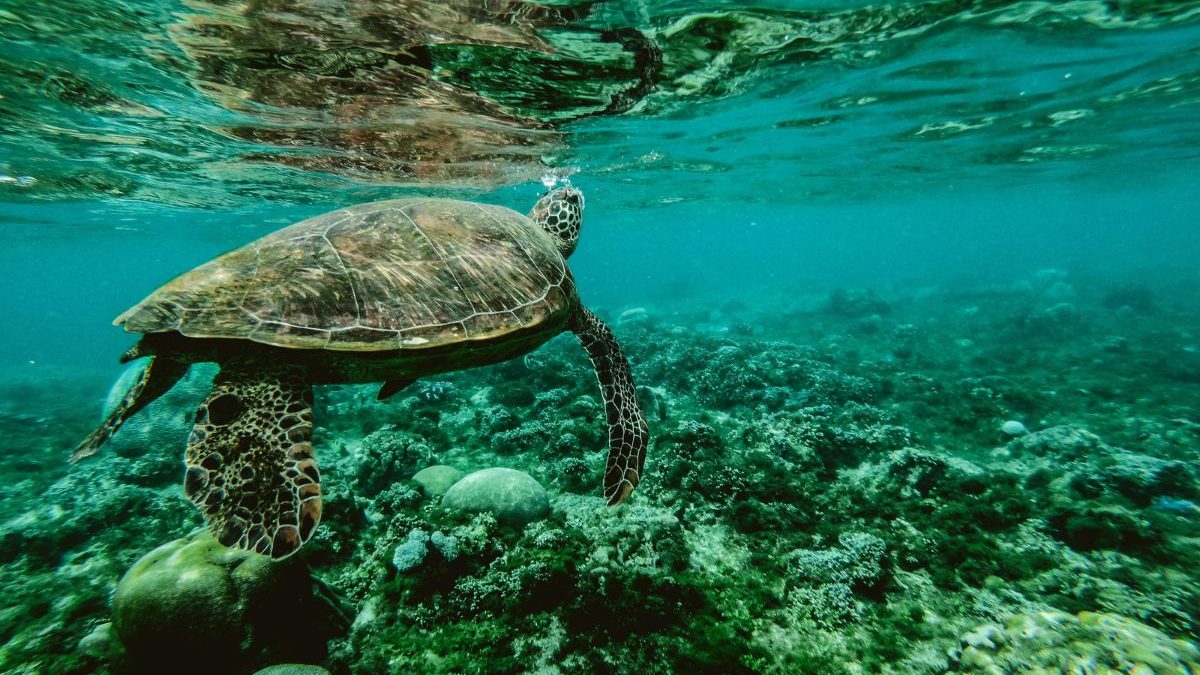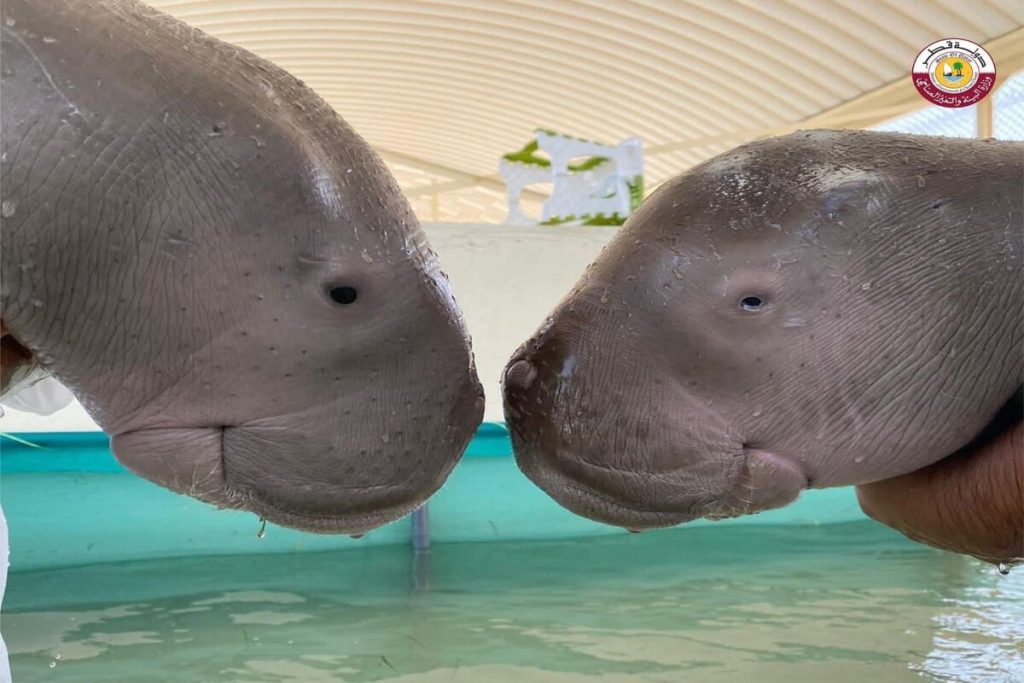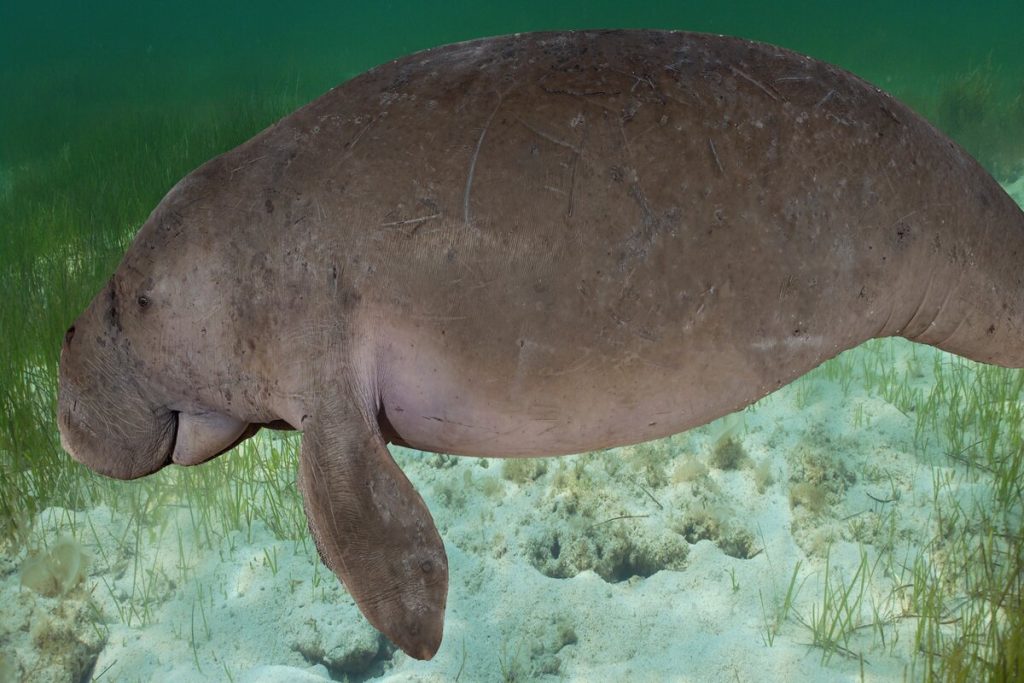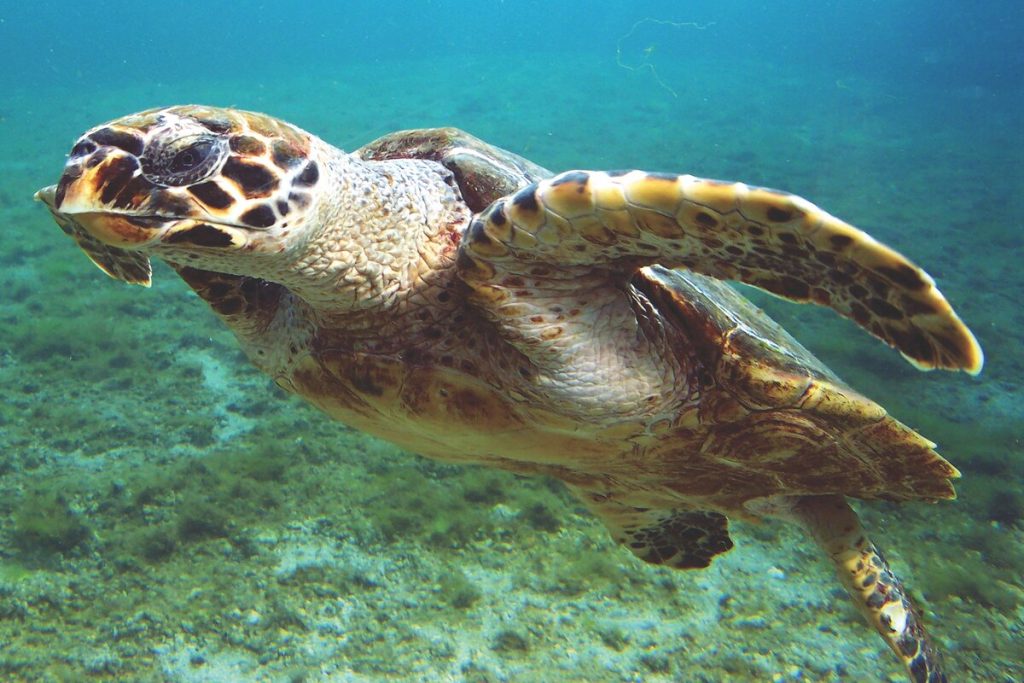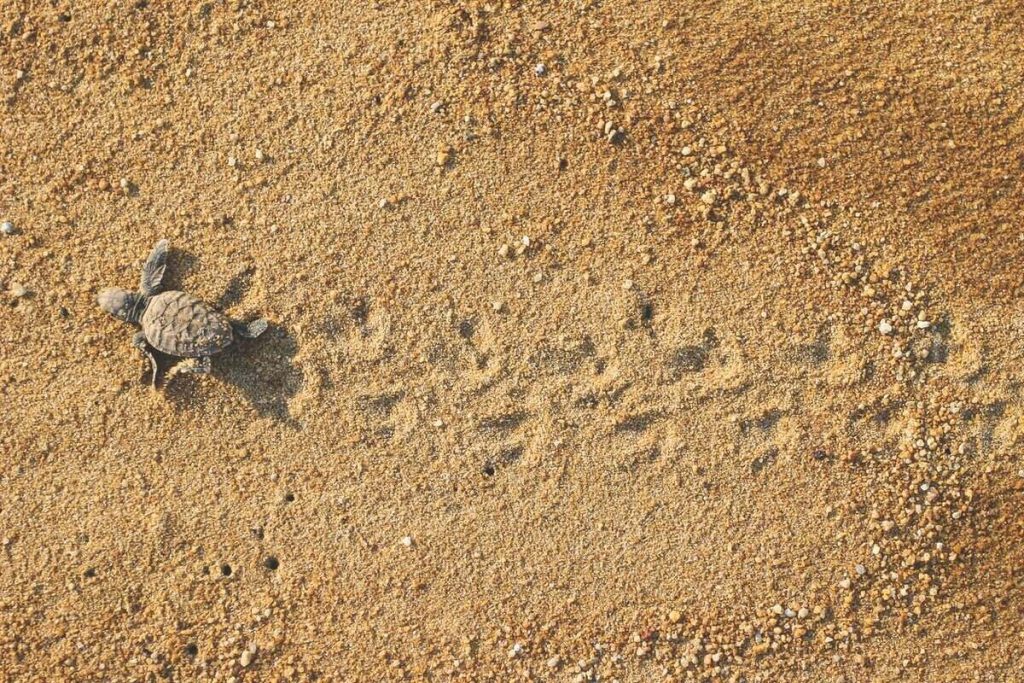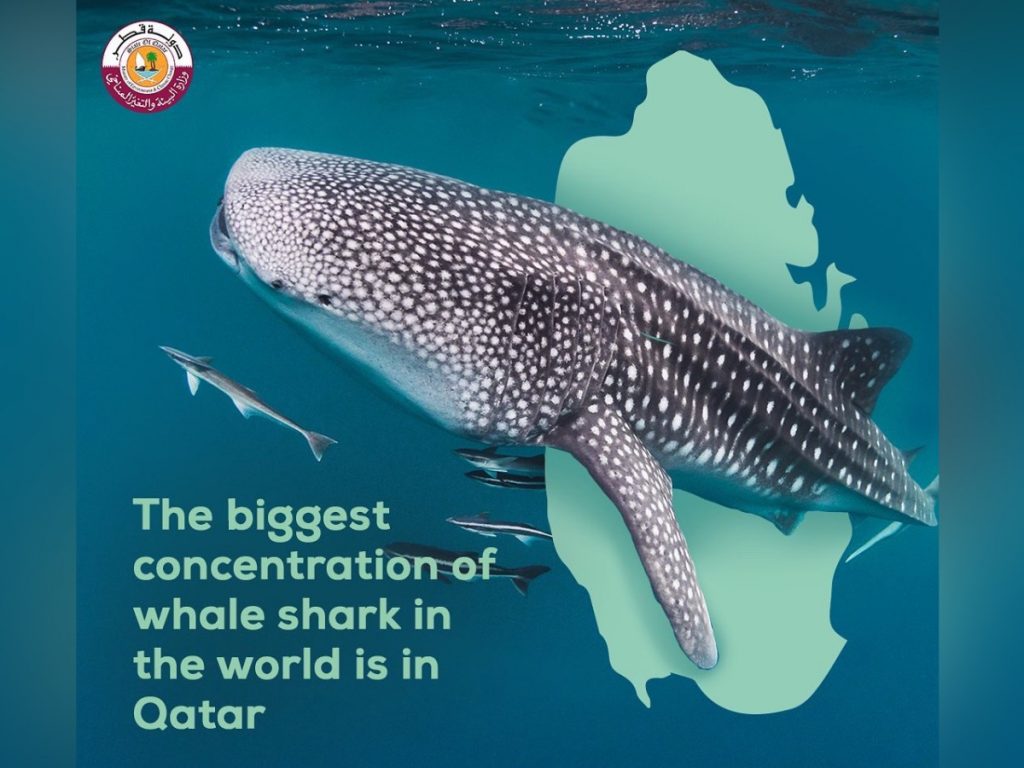Qatar is a peninsula, surrounded by the waters of the Persian Gulf, a Mediterranean sea and extension of the Indian Ocean, which is also known as the Arabian Gulf.
This surrounds Qatar with rich and diverse marine life, home to many fishes and mammals such as Arabian Blue Angel Fish, Sergeant Major, Grouper, Batfish, Barracuda, and more. Some people have been lucky enough to encounter whale sharks, sea turtles, Parrot Fish, dolphins, sea snakes or nursing sharks.
Qatar is home to some of the largest populations of some sea animals such as whale sharks and dugongs. Some species are in need of protection such as the hawksbill turtles.
Discover Qatar and other tourist agencies offer diving excursions. Discover the underwater marine life of Qatar through locally guided shore dives. If you are a certified diver, you will dive a range of sites, which are sheltered with small natural rocky reef, located up to 18 m deep and suited to open water qualified divers only. discoverqatar.qa/discover-qatars-marine-life/overview
Dugong
According to Visit Qatar, the world’s second largest population of dugongs live in Qatar, with herds of 600-700 dugongs recorded in Qatar’s waters recently. Known as sea cows, dugongs may live in the sea, but they are not really fish. They are marine mammals, and it’s believed they made their first appearance in the waters of the Arabian Gulf approximately 7,500 years ago.
The grey dugongs can grow up to over 90 m in length with an average body weight of 550 kg. They can easily move around in the water with paddle-like flippers and horizontal tails which are called flukes. They have a bristled snout and strong upper lips so they can easily uproot the entire seagrass plant to eat. Dugongs have small eyes, so their vision is limited, but their hearing is sharp and they can communicate using chirps and squeaks that travel through water. Their life expectancy, on average, is 70 years.
Although classified as a mammal, dugongs are herbivores and live on seagrass with eating being their main source of activity. On average, they consume about 40 kg of seagrass on a daily basis which is found in the clear, shallow and warm waters of the Arabian Gulf.
Dugongs are shy and move around in a semi-nomadic life with their mothers as calves and alone as adults. However, they have been spotted in larger herds in the northwestern area of Qatar. They fear humans and will turn away if they feel threatened.
Dugongs play a huge part in the ecosystem around Qatar. Careful research is being done to ensure they don’t go extinct because they are listed as ‘vulnerable’ by the International Union for Conservation of Nature (IUCN).
The equivalent of roughly two football fields of sea grass is lost each year – which is why a team of experts in Qatar are attempting to rebuild and restore seagrass meadows. The team collects samples – checking on the water quality to see if new plants are thriving. The meadows provide shelter, refuge and food for many marine species.
Depicting the importance of the dugong to Qatar are the various artworks across Qatar dedicated to the marine mammal. For FIFA World Cup Qatar 2022™, Qatar Museums (QM) commissioned permanent art installment Dugong by American artist Jeff Koons at Al Masrah Park on Doha Corniche. Standing at a height of over 21 m and stretching across a length of 31 m, the inflatable dugong is a larger than life imagining of the creature, gliding effortlessly through a marine habitat; a celebration of Qatar’s natural heritage. Another art installation of a family of six dugongs stands in Al Ruwais Beach by Iraqi artist Ahmed Al Bahrani.
Hawksbill turtles
Hawksbill turtles are the most endangered of the seven species of sea turtles, with estimates suggesting there are less than 25,000 nesting females globally. Qatar has at least four species of sea turtles – green, hawksbill, olive ridley and loggerhead – with dedicated efforts to care for the endangered hawksbill turtles.
Once one of Qatar’s most popular beaches, Fuwairit Beach permanently closed in 2020 to protect the endangered sea turtles during the hatching season. It has become a conservation area and sanctuary for turtles and birds to live and breed.
Throughout the years, the majority of the nesting has taken place in Fuwairit Beach. It is believed to be the most preferred location for the turtles to nest because of the nature of the beach. Fuwairit’s soft sand makes it the perfect place for nesting as turtles can easily dig into the sand to lay their eggs. The nesting area is fenced and closed to the public as the Fuwairit beach alone accommodates close to 30% of all sea turtle nests in the country. Nesting and hatching has been recorded in beaches neighbouring Fuwairit in the north of Qatar including Halul, Lehwaylah, Al Jassasiya, Al Maroona, Al Ghariya and Al Mafjar. A timetable has been made to ensure the presence of researchers and other team members around the clock while turtles are nesting on these beaches.
The hawksbill turtles lay around 60 to 200 eggs during the nesting season wherein they pick a spot, dig a hole to lay the eggs and return back to the sea after covering the eggs with sand. When the need arises, these eggs are transferred to safer nests and protected until the hatchlings emerge.
The mating process for hawksbill sea turtles takes place every two years and the nesting process begins in late March or early April, with the females leaving the sea and looking for a suitable nesting ground.
The annual hatching phase of the hawksbill turtle, which have been classified as an endangered species by the International Union for Conservation of Nature in 1982, takes place from the beginning of June until the end of July.
With funding from QatarEnergy (QE), Ministry of Environment and Climate Change (MECC) takes a number of steps to protect the endangered sea turtles during the hatching season. Qatar is home to four species of sea turtles, the most important of which is the hawksbill, which is of great importance to the region’s ecosystem.
MECC’s Wildlife and Protection Department consists of a team of highly qualified environmental inspectors and observers to supervise the project site. The team collects data on the turtle nesting season, including date, time and distance between the nest and the edge of the water.
The project began in 2003 as part of the Environmental Science Center (ESC) at Qatar University (QU), which implemented the Qatar Turtle Project to protect Qatar’s hawksbill sea turtles. This project is one of the most important projects towards preserving Qatar’s marine life.
QM offers a chance for Culture Pass Family members to get up close and witness the miracle of life in its purest form. The Turtle Hatching Encounters are commonly open annually in June and July during the hawksbill sea turtle hatching season. These exclusive guided tours have been organised in collaboration with MECC, Dadu, Children’s Museum of Qatar and Qatar Natural History Group.
Whale Sharks
According to MECC, Qatar’s concentration of whale sharks reached 600 sharks in 2020 – that is yet to be documented anywhere else in the world – and more than 100 sharks have been observed in Al Shaheen oilfield. The giant white-spotted fish annually congregate 90 km away from land between the months of April and September.
The ministry is calling on the community to not approach shark gatherings if spotted and to not publicise their location. Any sighting should be reported directly to the call centre at 184. Any unsettling noises are forbidden near the areas of the sharks’s gatherings to ensure their safety and wellbeing.
While these magnificent creatures are the biggest fish in the ocean, they are not invasive or predatory creatures and do not affect the region’s fish wealth.
The reason this region attracts so many whale sharks is because of its unique ecosystem. The average seawater temperature in the gulf averages between 32-34°C during the summer months. However, the seawater around the whale shark viewing location is a much cooler 27°C – perfect for fish to breed. It is the abundance of fish eggs, the whale sharks number one source of food, which attracts them to the area.
Qatar has been making several strides to protect whale sharks such as the Qatar Forum for the Protection of Whale Sharks in May 2023, Qatar Whale Shark Research and more.
Whale sharks (Rhincodon typus) are the largest shark, and indeed largest of any fish alive today. They feed on plankton, which are a collection of tiny organisms that live at and beneath the surface of lakes, rivers, ponds and oceans across the planet. The distribution of whale sharks indicates the presence of plankton and the overall health of our oceans. Whale sharks are found in all the tropical oceans of the world. Their white spotted colouration makes these gentle giants easy to distinguish.
The sharks travel large distances to find enough food to sustain their huge size, and to reproduce. According to the World Wildlife Fund (WWF), the maximum size of whale sharks is not known, but could be as large as 20 m. Females give birth to live young, but this has never been observed. Where pupping occurs and where the youngest animals situate remains a mystery, as they are very rarely found. Adults are often found feeding at the surface, but may dive to 1,000 m. Whale sharks are protected from fishing in many countries these days, but are in decline in some areas. Source: World Wildlife Fund (WWF)
The area where the whale sharks gather has been closed to the public until recently. Since 2022, Discover Qatar, the Destination Management Company (DMC) for Qatar Airways, and Qatar Airways Holidays have introduced tour packages to give people the chance to see the gigantic white-spotted fish in their natural habitat. The ‘Whale Sharks in Qatar’ tour packages include a luxurious ‘Private Charter’ yacht and ‘The Daily Explorer’ tour on a high-speed catamaran. In addition, Qatar Airways Holidays has its own whale shark tours, which offer return flight tickets with Qatar Airways, a chance to stay in one of Qatar’s luxurious hotels and more. Excursions open in May and close in August. For more information, visit discoverqatar.qa/whale-sharks-of-qatar
On Lusail Boulevard is Al Nehem, a 30 m large whale shark art installation by Italian artist Marco Balich of Balich Wonder Studio. Suspended 20 m above Lusail Plaza between the four Lusail Towers designed by Sir Norman Foster’s architectural firm, Foster + Partners, the aluminium and steel whale shark is brought to life with lights and music, with a bespoke composition by maestro Roberto Cacciapaglia. Qatari Diar has unveiled the art installation to celebrate Lusail’s development and raise awareness for one of the largest endangered animals in the world; and as a tribute to Qatar’s endangered marine species and a symbol of the country’s concern for the conservation and preservation of their natural environment.
Author: Ola Diab
Copyright © Marhaba Information Guide. Reproduction of material from Marhaba Information Guide’s book or website without written permission is strictly prohibited. Using Marhaba Information Guide’s material without authorisation constitutes plagiarism as well as copyright infringement.


